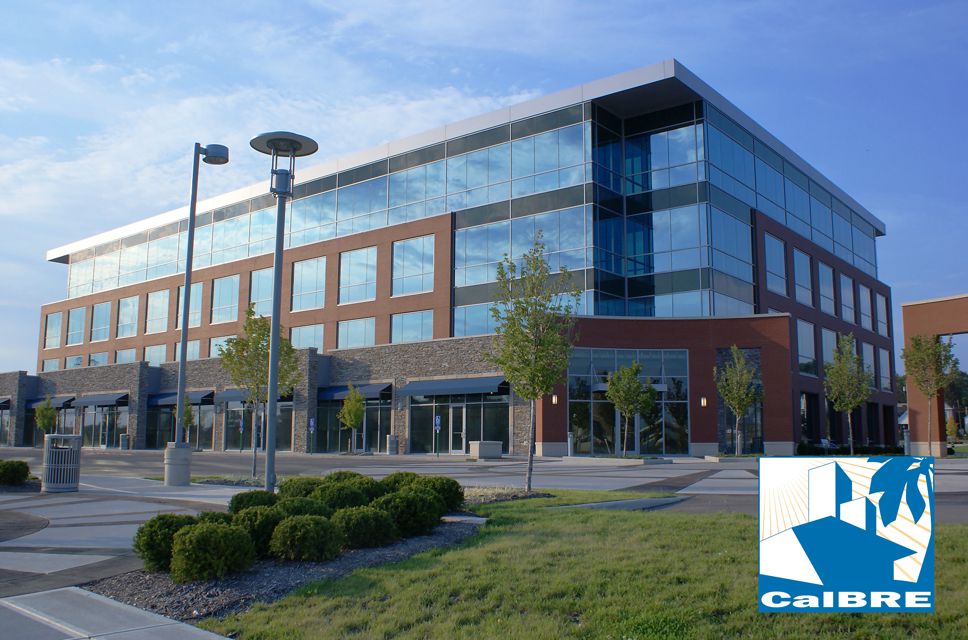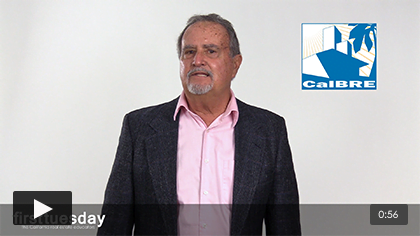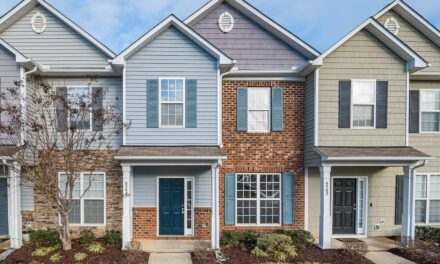Ever wonder what happens to your license renewal fees? Or who’s knocking at your brokerage’s door for an audit? This article introduces the California Bureau of Real Estate (CalBRE), the state agency behind your real estate license. Read on for a breakdown of the agency’s structure and activities.
Several years have passed since the California Bureau of Real Estate (CalBRE) was reorganized, but first tuesday still gets the question: “What’s CalBRE?”
To answer that question, and maybe a few others, let’s take a look into the CalBRE.
CalBRE = not the union
CalBRE is the California state agency charged with overseeing California real estate brokers and agents.
One of the most common misconceptions is that the CalBRE is the same entity as or a branch of the real estate trade union. However, CalBRE is not your local real estate board, the California Association of Realtors (CAR), first tuesday or any other real estate educator.
Authority
CalBRE’s primary mandate is to administer and enforce California’s Real Estate Law and Subdivided Lands Law. This includes licensing agents and brokers, approving subdivisions and acting as a consumer protection agency. The agency’s highest official priority is protection of members of the public. [Calif. Business & Professions Code §§10000-11288; 10050.1]
To achieve this mandate, CalBRE develops and promulgates rules governing the licensure, conduct and discipline of real estate practitioners statewide. These rules are found in the Regulations of the Real Estate Commissioner, contained in the California Code of Regulations. [10 CCR §2705-3109]
CalBRE was known once upon a time as the Department of Real Estate (DRE). The California DRE was established in 1917 as an independent state agency headed by the Office of the Commissioner of Real Estate— the first such agency in the country.Sti
In July 2014, the DRE was folded into the Department of Consumer Affairs (DCA), where it became a bureau (hence CalBRE) within that department as part of Governor Jerry Brown’s Government Reorganization Plan of 2012. The DCA provides administrative support to CalBRE and the dozens of other semi-autonomous bureaus, boards and commissions under the department’s umbrella. [Calif. Gov. Code §8523]
Reorganization did not affect the role of Office of the Real Estate Commissioner. CalBRE is still led by the Commissioner of Real Estate. Commissioners are appointed by the governor, typically for the duration of the governor’s term in office or until the commissioner resigns.
Since 2013, that role has been filled by Commissioner Wayne E. Bell. Commissioner Bell is the first person to attain the position of Commissioner from within the agency during its long history. Prior to his appointment, Commissioner Bell served as the chief legal counsel to his predecessor for seven years. During that time Bell also had a hand in CalBRE’s regulatory, legislative, disciplinary and recovery account functions.
Related video:
Funding
CalBRE is a special fund agency. Thus, almost its entire operating budget is funded by revenues generated from its activities, rather than the state’s General Fund. CalBRE’s primary revenue sources include:
- license application and renewal fees;
- subdivision filing fees; and
- fines.
The vast majority of CalBRE’s revenue comes from license fees. Of CalBRE’s projected $53.6 million 2017-2018 revenue, $39.5 million is anticipated to be derived from license application and renewal fees ($245 for sales agents and $300 for brokers).
Budget expenditures are expected to clock in at $55.2 million for the 2017-2018 fiscal year. The agency also carries an emergency reserve consisting of unspent revenue from previous years, which totals $38.7 million in 2017-2018. CalBRE works with DCA to create three-year revenue and expenditure estimates on an annual basis. CalBRE also holds annual hearings to evaluate raising or lowering licensing and subdivision fees as required by state law. [Bus & PC §10226]
Editor’s note — See a breakdown of these figures in the 2017-2018 State Budget for the Department of Consumer Affairs.
The Real Estate Recovery Fund is also funded by CalBRE revenue. The agency is statutorily compelled to devote 12% of annual licensing fee revenue to the Recovery Fund. [Bus & PC §10450.6]
CalBRE occasionally partners with colleges and universities to conduct research and create educational materials. Outside of this, it does not contract with private sector providers to perform any of its core functions, according to a DCA spokesperson.
Organization
CalBRE maintains five offices in the state’s major metropolitan regions:
- Fresno;
- Los Angeles;
- Oakland;
- Sacramento (headquarters); and
- San Diego.
Across these five regional offices CalBRE maintains a staff of between 325-350 civil service employees, from customer service and clerical staff to auditors, analysts, legal advisors and administrators. The agency administers licenses for just over 413,000 active and inactive brokers and agents as of the first quarter (Q1) of 2017. [CalBRE Fall 2016 Real Estate Bulletin]
Six major sections exist within CalBRE, each with component subsections:
- administration and licensing (A&L)
- audits;
- enforcement;
- legal;
- subdivisions; and
- an executive team.
Each section is led by an Assistant Commissioner. We’ll take a brief look at the core functions of each of these sections.
Administration and licensing (A&L)
This section oversees license issuance and renewal. A&L is also responsible for upholding the educational and experience requirements for agents and brokers seeking to renew or obtain a real estate license.
The licensing side of the A&L section is split into two subsections.
Exams, Education and Research handles pre-licensing issues and activities including:
- development and administration of licensing exams;
- original license application evaluation and processing;
- evaluation of broker license applicant experience and substitute educational experience; and
- maintenance of licensing records.
The Licensing Services arm of A&L is in charge of post-licensing activities, including:
- tracking and processing license expirations and renewals;
- mortgage loan originator (MLO) endorsement applications and renewals; and
- public licensing information including the License Lookup.
The Exams, Education and Research subsection approves all pre-licensing and license renewal courses offered by educators such as first tuesday. This approval includes course syllabi and reading materials, quizzes and exam questions, both in print and online, plus supplemental materials such as course instructions and online user interfaces.
Related video:
CalBRE gave a total of 46,693 exams in 2015-2016 according to the CalBRE’s most recently available data. Nearly 23,685 exams were passed.
Finally, A&L is also home to:
- the Flag Administration subsection, which processes all licensee disciplinary actions and responds to records requests relating to court proceedings and other legal actions; and
- the Business Services office, which in conjunction with DCA manages CalBRE procurement and vendor contracts.
Audits
CalBRE’s Audit section is divided into Northern and Southern services areas. The Audits North subsection serves Northern California, the Bay Area and the San Joaquin Valley out of the Fresno, Oakland and Sacramento offices.
The Audits South subsection serves all Southern California out of the Los Angeles and San Diego offices.
Audits is responsible for initiating and conducting reviews of agents and brokerages for compliance with:
- rules for trust fund handling;
- licensing and renewal status; and
- recordkeeping standards.
When the CalBRE performs audits, they are either:
- investigative audits initiated based on complaints from the public or other information about possible violations; or
- routine audits targeting randomly selected brokers, mortgage loan brokerages, property managers and broker-owned escrows.
The regional subsection tasked with conducting an audit will request documents and records and present questions to members of the brokerage office. If violations are found the auditor refers the case to the Enforcement section.
According to the 2015-2016 CalBRE statistics, the Audits section conducted 590 audits.
Enforcement
CalBRE’s Enforcement section investigates and disciplines licensee misconduct in response to audits or complaints from the public, or at the direction of law enforcement agencies or other legal authorities.
The Enforcement section is comprised of three regional offices covering various territories:
- Enforcement Region I serves San Diego and Los Angeles South;
- Enforcement Region II serves Fresno and Los Angeles North; and
- Enforcement Region III serves Northern California out of the Sacramento and Oakland district offices.
Region III is also home to the Citations and Fines Compliance Office.
Enforcement receives and reviews consumer complaints and initiates an investigation when a complaint is deemed actionable. If CalBRE determines an investigation is in order, investigators take action as quickly as within 24 hours, depending on potential risk to the public. High-priority cases involve ongoing perils to the public, such as allegations of embezzlement or fraud.
Actionable complaints become cases, and the assigned investigator serves as the point of contact for the complaint. Investigators review complaints and, if necessary:
- request additional documentary evidence;
- inspect documents; and
- take statements from involved parties.
In the 2016 DCA Annual Report, CalBRE reports it received 5,341 complaints from the public, referring 2,814 of those for investigation and closing 2,495 without referral. In the same period a total of 2,193 investigations were opened (or remained open from previous terms), and 2,708 investigations concluded.
When Enforcement identifies a violation of the Real Estate or Subdivided Lands law it has the authority to cite and fine both licensees and unlicensed individuals. Citations are essentially disciplinary warnings for minor infractions, but sometimes include an Order of Correction requiring the violator to remedy the issue and provide a statement attesting to that remedy.
Administrative fines are issued for more serious violations. The maximum fine for both a licensee and an unlicensed person is $2,500 per citation or unlicensed act. CalBRE Enforcement issued 774 citations and fines in 2016 netting $356,634 according to DCA’s most recent Annual Report. [10 Calif. Code of Regulations §2907.2]
If further legal action is necessary Enforcement refers the case to the Legal section.
Legal
The Legal section operates out of the Los Angeles and Sacramento District Offices. Investigations or audits that uncover major violations of the Real Estate or Subdivided Lands Law are prosecuted administratively by the Legal section. Legal also provides general policy advice, guidance and support to the Commissioner and CalBRE management and staff, and assists DCA in advising lawmakers and other government entities on legal issues pertaining to real estate.
When a violation is identified, the Legal section files an Accusation describing the facts and basis for action with the California Office of Administrative Hearings (OAH). The accused licensee has the opportunity to respond with a Notice of Defense, after which the case proceeds to a hearing before an OAH Administrative Law Judge (ALJ).
If the accused licensee does not respond with a Notice of Defense, Legal assists the Commissioner to evaluate the circumstances of the case. It then files a Default Decision and determines what disciplinary action will be taken.
If the licensee does intend to defend themselves at the hearing, CalBRE has the burden of proving the charges brought before the ALJ. Once the arguments have been made and the evidence examined, the ALJ sends a proposed ruling to the Commissioner for final decision.
The Commissioner can adopt or reject and reduce the proposed disciplinary action submitted by the ALJ. If the Commissioner wishes to enhance the ALJ’s proposed consequences, they are required to personally review the facts before issuing their Decision After Rejection.
Decisions may be appealed to the Commissioner for reconsideration. Alternatively, the accused licensee may take their appeal to the appropriate Superior Court, Court of Appeals or California Supreme Court. In 2016, CalBRE’s Legal section referred a total of 29 cases for civil or criminal action.
California’s Real Estate Recovery Fund is also administered through CalBRE’s Legal section. The Recovery Fund is available to persons awarded a court judgment or an arbitration award against a real estate licensee based on:
- fraud, misrepresentation or deceit with intent to defraud;
- criminal restitution; or
- conversion of trust funds. [Calif. Business and Professions Code §10471]
Consumers are eligible for Recovery Fund awards when they are unable to recover from the licensee and all other methods of recovery, such as recovery under title or errors and omissions (E&O) insurance, have been exhausted. The maximum recoverable amount is:
- $50,000 for each transaction; and
- $250,000 for any one licensee. [Bus & P C §10474]
Judgment against a licensee paid from the Recovery Fund results in the suspension of their license until the amount paid on their behalf is repaid, plus interest. According to DCA’s Annual Report, CalBRE’s Legal section received 73 Recovery Fund claims in the 2016 term. 81 claims were paid (including those from prior periods), totaling almost $3.4 million.
Subdivisions
CalBRE’s Subdivisions section enforces the Subdivided Lands Law and Subdivision Map Act. These laws require that buyers get what they pay for from developers of residential subdivisions, common interest developments (CIDs), housing cooperatives and timeshares.
To do this, Subdivisions requires developers and subdividers to submit detailed technical and financial information about a proposed subdivision including:
- maps of the proposed tract and plots, or the proposed CID;
- proposed conditions, covenants and restrictions (CC&Rs) and homeowners’ association (HOA) bylaws;
- anticipated HOA dues, maintenance fees and other assessments;
- evidence of agreements with utility and public safety service providers;
- documentation of all required approvals from state agencies;
- title condition reports;
- proposed project budgets and construction contracts;
- proposed marketing materials and sample sales contracts; and much more.
CalBRE Subdivisions uses these application packages to generate a Subdivision Public Report. The subdivider is required to disclose the Public Report to all prospective purchasers of property before they enter into a binding agreement to purchase a lot or interest in the subdivision, similar to mandatory property disclosures for sellers of one-to-four unit residential property.
Subdivision Public Reports are available in many varieties depending on the type of subdivision or CID proposed, completeness of the subdivider’s application, stage of completion of the subdivision itself or changes made to the planned development after the application is submitted.
CalBRE Subdivisions operates a Northern subsection out of the Sacramento office, and a Southern subsection out of the Los Angeles office. In the 2016 term, Subdivisions received 3,165 original applications from subdividers for public reports and issued 2,764 original public reports, according to the DCA’s Annual Report.
Editor’s note — See the DCA’s Annual Report for 2016 here.
This article was previously posted in 2015, and has been updated to reflect current data.















“CalBRE is still lead” – maybe led?